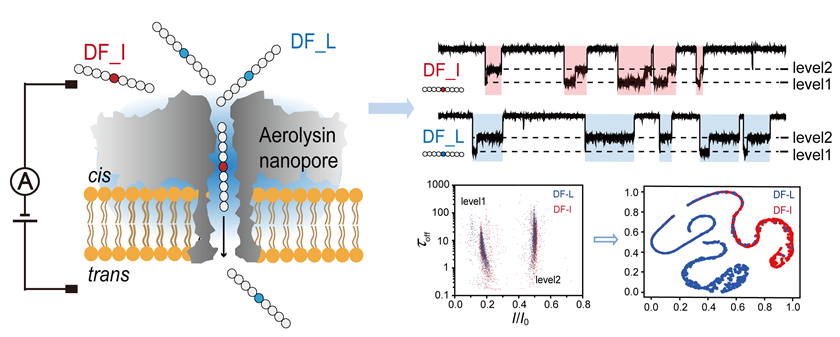| [1] |
Afshar Bakshloo M.; Kasianowicz J. J.; Pastoriza-Gallego M.; Mathé J.; Daniel R.; Piguet F.; Oukhaled A. J. Am. Chem. Soc. 2022, 144, 2716.
doi: 10.1021/jacs.1c11758
|
| [2] |
Derrington I. M.; Butler T. Z.; Collins M. D.; Manrao E.; Pavlenok M.; Niederweis M.; Gundlach J. H. Proc. Natl. Acad. Sci. U. S. A. 2010, 107, 16060.
doi: 10.1073/pnas.1001831107
|
| [3] |
Hu Z.-L.; Huo M.-Z.; Ying Y.-L.; Long Y.-T. Angew. Chem., Int. Ed. 2021, 60, 14738.
doi: 10.1002/anie.v60.27
|
| [4] |
Pratanwanich P. N.; Yao F.; Chen Y.; Koh C. W.; Wan Y. K.; Hendra C.; Poon P.; Goh Y. T.; Yap P. M.; Chooi J. Y. Nat. Biotechnol. 2021, 39, 1394.
doi: 10.1038/s41587-021-00949-w
|
| [5] |
Goenka S. D.; Gorzynski J. E.; Shafin K.; Fisk D. G.; Pesout T.; Jensen T. D.; Monlong J.; Chang P. C.; Baid G.; Bernstein J. A. Nat. Biotechnol. 2022, 40, 1035.
doi: 10.1038/s41587-022-01221-5
|
| [6] |
Sheng Y.; Zhou K.; Liu L.; Wu H.-C. Angew. Chem., Int. Ed. 2022, 61, e202200866.
doi: 10.1002/anie.v61.20
|
| [7] |
Ju Y.; Pu M.; Sun K.; Song G.; Geng J. Chem. - Asian J. 2022, 17, e202200774.
doi: 10.1002/asia.v17.22
|
| [8] |
Zhang Z.; Li T.; Sheng Y.; Liu L.; Wu H.-C. Small 2019, 15, 1804078.
doi: 10.1002/smll.v15.2
|
| [9] |
Tsutsui M.; Yokota K.; Yoshida T.; Hotehama C.; Kowada H.; Esaki Y.; Taniguchi M.; Washio T.; Kawai T. ACS Sens. 2019, 4, 748.
doi: 10.1021/acssensors.9b00113
|
| [10] |
Tanimoto I. M. F.; Cressiot B.; Greive S. J.; Le Pioufle B.; Bacri L.; Pelta J. Nano Res. 2022, 15, 9906.
doi: 10.1007/s12274-022-4379-2
|
| [11] |
Wu X. Y.; Ying Y. L.; Long Y. T. Chem. J. Chin. Univ. 2019, 40, 1825. (in Chinese)
|
|
( 武雪原, 应佚伦, 龙亿涛, 高等学校化学学报, 2019, 40, 1825.)
|
| [12] |
Wang L. Y.; Wang H. W.; Lu S. M.; Long Y. T. Chin. J. Anal. Chem. 2021, 49, 1166. (in Chinese)
|
|
( 王凌远, 王浩炜, 芦思珉, 龙亿涛, 分析化学, 2021, 49, 1166.)
|
| [13] |
Lu Y.; Hu Z. L.; Ying Y. L.; Long Y. T. J. Instrum. Anal. 2019, 38, 129. (in Chinese)
|
|
( 路瑶, 胡正利, 应佚伦, 龙亿涛, 分析测试学报, 2019, 38, 129.)
|
| [14] |
Chen Z.; Wang Z.; Xu Y.; Zhang X.; Tian B.; Bai J. Chem. Sci. 2021, 12, 15750.
doi: 10.1039/D1SC04342K
|
| [15] |
Zernia S.; van der Heide N. J.; Galenkamp N. S.; Gouridis G.; Maglia G. ACS Nano 2020, 14, 2296.
doi: 10.1021/acsnano.9b09434
|
| [16] |
Niu H. Y.; Hu Z. L.; Ying Y. L.; Long Y. T. Acta Chim. Sinica 2019, 77, 989. (in Chinese)
doi: 10.6023/A19060230
|
|
( 牛红艳, 胡正利, 应佚伦, 龙亿涛, 化学学报, 2019, 77, 989.)
|
| [17] |
Li M. Y.; Ying Y. L.; Long Y. T. Acta Chim. Sinica 2019, 77, 984. (in Chinese)
doi: 10.6023/A19060202
|
|
( 李孟寅, 应佚伦, 龙亿涛, 化学学报, 2019, 77, 984.)
|
| [18] |
Huo M.-Z.; Li M.-Y.; Ying Y.-L.; Long Y.-T. Anal. Chem. 2021, 93, 11364.
doi: 10.1021/acs.analchem.1c00851
|
| [19] |
Ouldali H.; Sarthak K.; Ensslen T.; Piguet F.; Manivet P.; Pelta J.; Behrends J. C.; Aksimentiev A.; Oukhaled A. Nat. Biotechnol. 2020, 38, 176.
doi: 10.1038/s41587-019-0345-2
|
| [20] |
Xin K.-L.; Hu Z.-L.; Liu S.-C.; Li X.; Li J.-G.; Niu H.; Ying Y.-L.; Long Y.-T. Angew. Chem., Int. Ed. 2022, 61, e202209970.
doi: 10.1002/anie.v61.44
|
| [21] |
Hu R.; Rodrigues J. V.; Waduge P.; Yamazaki H.; Cressiot B.; Chishti Y.; Makowski L.; Yu D.; Shakhnovich E.; Zhao Q. ACS Nano 2018, 12, 4494.
doi: 10.1021/acsnano.8b00734
|
| [22] |
Liu Y.; Zhang S.; Wang Y.; Wang L.; Cao Z.; Sun W.; Fan P.; Zhang P.; Chen H. Y.; Huang S. J. Am. Chem. Soc. 2022, 144, 13717.
doi: 10.1021/jacs.2c04595
|
| [23] |
Li S. J.; Li X.; Wan Y.-J.; Ying Y.-L.; Yu R.-J.; Long Y.-T. Chem. - Asian J. 2023, 18, e202201144.
doi: 10.1002/asia.v18.3
|
| [24] |
Liu S.-C.; Li M.-X.; Li M.-Y.; Wang Y.-Q.; Ying Y.-L.; Wan Y.-J.; Long Y.-T. Faraday Discuss. 2018, 210, 87.
doi: 10.1039/C8FD00023A
|
| [25] |
Li X.; Ying Y.-L.; Fu X.-X.; Wan Y.-J.; Long Y.-T. Angew. Chem., Int. Ed. 2021, 60, 24582.
doi: 10.1002/anie.v60.46
|
| [26] |
Desplanques B.; Thienpondt J.; Demuynck K.In 21st Annual Conference of the International Speech Communication Association (INTERSPEECH 2020), Shanghai, 2020, pp. 3830-3834.
|
| [27] |
Morlet J.; Arens G.; Fourgeau E.; Giard D. Geophysics 1982, 47, 222.
doi: 10.1190/1.1441329
|
| [28] |
Niu H.; Li M.-Y.; Ying Y.-L.; Long Y.-T. Chem. Sci. 2022, 13, 2456.
doi: 10.1039/D1SC06459B
|
| [29] |
Cao C.; Li M.-Y.; Cirauqui N.; Wang Y.-Q.; Dal Peraro M.; Tian H.; Long Y.-T. Nat. Commun. 2018, 9, 2823.
doi: 10.1038/s41467-018-05108-5
|
| [30] |
Fawcett T. Pattern Recognit. Lett. 2006, 27, 861.
doi: 10.1016/j.patrec.2005.10.010
|
| [31] |
Van der Maaten L.; Hinton G. J. Mach. Learn. Res. 2008, 9, 2579.
|
| [32] |
Yang C. Y.; Gu Z.; Hu Z. L.; Ying Y. L.; Long Y. T. J. Electrochem. 2019, 25, 312. (in Chinese)
|
|
( 杨铖宇, 顾震, 胡正利, 应佚伦, 龙亿涛, 电化学, 2019, 25, 312.)
|
 ), 蒋翠玲a,*(
), 蒋翠玲a,*( ), 万永菁a, 应佚伦b, 龙亿涛b
), 万永菁a, 应佚伦b, 龙亿涛b
 ), Cuiling Jianga(
), Cuiling Jianga( ), Yongjing Wana, Yi-Lun Yingb, Yi-Tao Longb
), Yongjing Wana, Yi-Lun Yingb, Yi-Tao Longb
